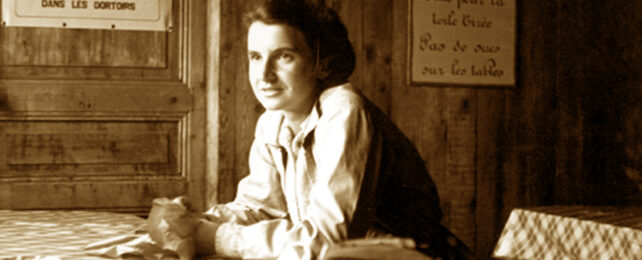Seventy years ago this week, news broke that scientists had discovered the double-helical structure of DNA, revealing the genetic material that encodes all life takes the form of two twisting strands held together by chemical threads.
The structure of DNA was described in three back-to-back papers, authored by some now-familiar household names. Among them was Rosalind Franklin, a chemist who died of ovarian cancer shortly thereafter, depriving her of the chance to celebrate her contributions or see them duly recognized.
Instead, James Watson and Francis Crick would go on to share a Nobel Prize with Franklin's colleague Maurice Wilkins, write best-selling books, and speak at length about how they pieced together the structure of DNA using data taken from a now-iconic image known as Photograph 51.
The picture's scatter of fuzzy dots was formed by X-rays refracting from DNA's molecular structure. Captured by Raymond Gosling, a student the chemist briefly inherited from Wilkins, the photograph meant little without Franklin's expert interpretation.
To what extent Franklin's experienced eye informed the path of discovery has been a topic of discussion ever since.
Now, two scientists writing biographies about Watson and Crick have uncovered more details about Franklin's contribution to the revelation of DNA's double helix in an overlooked letter and an unpublished news article from the 1950s.
"Together, these documents suggest a different account of the discovery of the double helix," write zoologist Matthew Cobb and medical historian Nathaniel Comfort in a commentary marking the anniversary of the 1953 Nature papers. "Franklin did not fail to grasp the structure of DNA. She was an equal contributor to solving it."
Cobb and Comfort rifled through an archive of Franklin's notes to reconstruct her ideas, outlining how the former student of Marie Curie produced far more than the one image she is most often known for.
Franklin conducted many careful measurements of her X-ray diffraction images, recording her data in an informal report. On making its way into the hands of Watson and Crick, the observations were used – without permission – to validate their theoretical model of DNA.
The molecule is a "big helix with several chains, phosphates on outside, phosphate–phosphate interhelical bonds, disrupted by water," Franklin had previously described in her 1951 seminar notes, a seminar Watson attended and casually dismissed.
While Watson and Crick certainly showed a cavalier disregard for other people's work, plucking data to back up their theories on the shape of DNA and only crediting contributions in retrospect, Cobb and Comfort cite the newly discovered documents to argue a subtly different account.
Franklin wasn't a naive outsider following her own path. The discovery of DNA's structure was the product of two teams who – to use a generous interpretation – often cross-checked their work.
"They linked up, confirming each other's work from time to time, or wrestling over a common problem," journalist Joan Bruce wrote in an unpublished article she drafted in consultation with Franklin.
Cobb and Comfort's retelling attempts to cast Franklin as "an equal member of a quartet who solved the double helix", but it also shows what happens when one person's popular version of events takes off and details written into scientific papers are left to gather dust.
Cobb and Comfort suggest it was Watson who distorted reality in his best-selling 1968 book, The Double Helix, by casting the day he first saw Photograph 51 as a classic 'eureka moment' that readers could understand.
This narrative – that Watson could recognize at a glance what Franklin had missed for months – is often perpetuated "unwittingly" by Franklin's advocates and undermines Franklin's contributions, Cobb and Comfort write. "It implies that Franklin, the skilled chemist, could not understand her own data, whereas he, a crystallographic novice, apprehended it immediately."
Cobb and Comfort suggest that Watson and Crick had actually attempted "to set the record straight" in a 1954 paper in which the duo confessed that "the formulation of our structure would have been most unlikely, if not impossible" without Franklin's data. Whether that reads as a glancing admission of guilt or an acknowledgment of their peer's hard work is difficult to discern; perhaps both are true.
Even with history showing Franklin as an equal contributor to our understanding of DNA, Cobb and Comfort argue that she was "beaten to the answer" of DNA's enchanting double helix for a few reasons that reflect the sexism she experienced as a woman in science.
Apart from her graduate student, Franklin worked "on her own without a peer with whom to swap ideas. She was also excluded from the world of informal exchanges in which Watson and Crick were immersed."
Franklin insisted on collecting and fully analyzing her X-ray diffraction data before formulating any models of how DNA fits together, and her and Gosling's 1953 paper was only published in Nature alongside the other two after Franklin petitioned for its inclusion.
And of course, it still stands that Wilkins shared with Watson the renowned Photograph 51, a particularly clear image of DNA as it exists inside watery cells – without Franklin's knowledge or permission.
Cobb and Comfort say the record should show Franklin as a brilliant scientist in her own right, who packed two lifetime's worth of discoveries into one, not one who failed to recognize the significance of her X-ray crystallography images.
"Getting Franklin's story right is crucial, because she has become a role model for women going into science," Cobb and Comfort write. "She was up against not just the routine sexism of the day, but also more subtle forms embedded in science – some of which are still present today."
The commentary was published in Nature.
